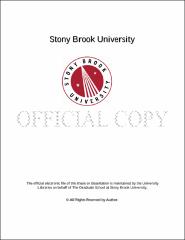| dc.identifier.uri | http://hdl.handle.net/11401/77366 | |
| dc.description.sponsorship | This work is sponsored by the Stony Brook University Graduate School in compliance with the requirements for completion of degree. | en_US |
| dc.format | Monograph | |
| dc.format.medium | Electronic Resource | en_US |
| dc.language.iso | en_US | |
| dc.publisher | The Graduate School, Stony Brook University: Stony Brook, NY. | |
| dc.type | Dissertation | |
| dcterms.abstract | A parallel, fully relativistic, 3D electromagnetic particle-in-cell (EM-PIC) code, named SPACE, has been developed for the simulation of relativistic particle beams, beam - plasma interaction, and plasma chemistry. New algorithms such as atomic processes in plasma, proper boundary conditions, and an efficient method for highly-relativistic beams in non-relativistic plasma have been developed. Algorithms for atomic process include ionization of neutral atoms by electron impact, recombination of plasma, and electron attachment on dopants in dense neutral gases. The code has been used for the simulation of processes in high-pressure radio-frequency (RF) cavity (HPRF) program at Fermilab. Advanced numerical simulations resolve all physically relevant processes in RF cavity filled with high-pressure gases and interacting with proton beams. Simulations also support broader research on the design of muon cooling devices. From simulation studies of microphysics processes, macroscopic and experimentally measurable quantities have been derived. Through comparison with experiments in the MTA, simulations quantified several uncertain values of plasma properties such as effective recombination rates and the attachment time of electrons to dopant molecules. Simulations have achieved very good agreement with experiments on plasma loading and related processes. The experimentally validated code SPACE will be used for simulations of muon cooling devices in regimes beyond current experimental capabilities. In addition, the code is used to study advanced coherent electron cooling (ACeC) for the e-RHIC project at BNL. Simulations study the modulation effect of highly relativistic ions of gold on co-propagating electron plasma and the amplification of modulation. Parallel simulations were able to track every real electron in physically relevant domains. | |
| dcterms.available | 2017-09-20T16:52:34Z | |
| dcterms.contributor | Samulyak, Roman V | en_US |
| dcterms.contributor | Glimm, James | en_US |
| dcterms.contributor | Jiao, Xiangmin | en_US |
| dcterms.contributor | Lin, Meifeng. | en_US |
| dcterms.creator | YU, KWANG MIN | |
| dcterms.dateAccepted | 2017-09-20T16:52:34Z | |
| dcterms.dateSubmitted | 2017-09-20T16:52:34Z | |
| dcterms.description | Department of Applied Mathematics and Statistics | en_US |
| dcterms.extent | 131 pg. | en_US |
| dcterms.format | Application/PDF | en_US |
| dcterms.format | Monograph | |
| dcterms.identifier | http://hdl.handle.net/11401/77366 | |
| dcterms.issued | 2016-12-01 | |
| dcterms.language | en_US | |
| dcterms.provenance | Made available in DSpace on 2017-09-20T16:52:34Z (GMT). No. of bitstreams: 1
YU_grad.sunysb_0771E_12871.pdf: 4768470 bytes, checksum: 6c63474e1cbad2de8d02c9133a9df9f9 (MD5)
Previous issue date: 1 | en |
| dcterms.publisher | The Graduate School, Stony Brook University: Stony Brook, NY. | |
| dcterms.subject | Applied mathematics | |
| dcterms.subject | Computational Electrodynamics, Numerical Simulation, Particle Accelerator, Particle-in-Cell | |
| dcterms.title | Computational Relativistic Electrodynamics: New Algorithms, Parallel Software, and Applications to Accelerator Design | |
| dcterms.type | Dissertation | |

